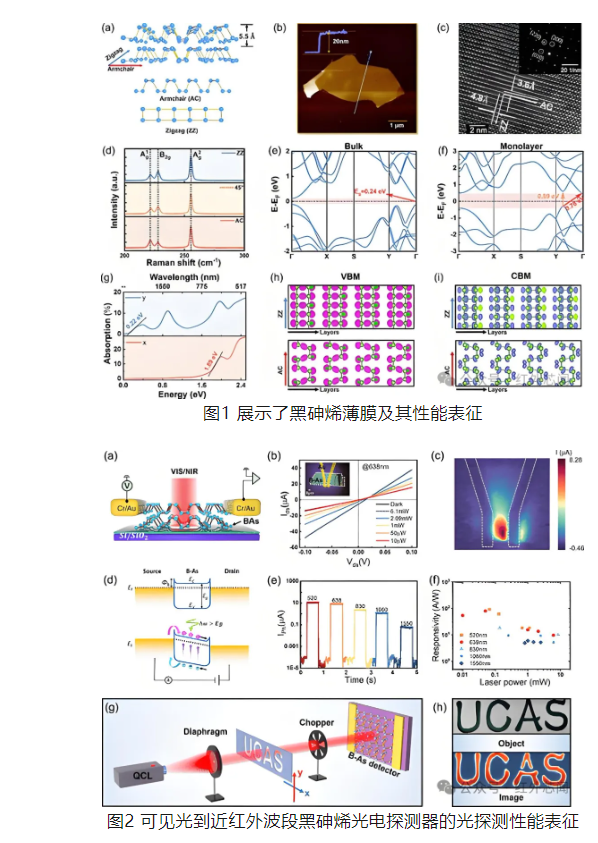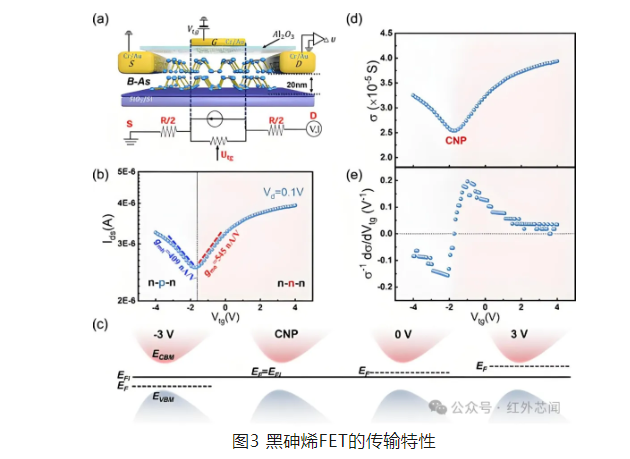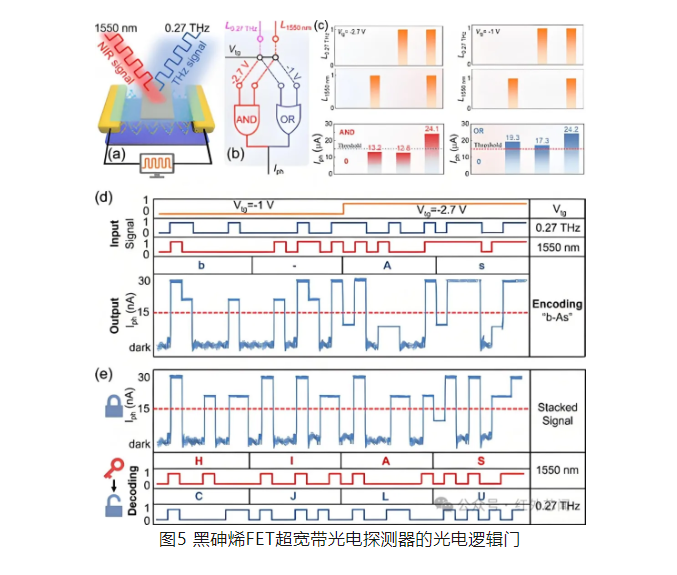08
2025
-
01
Black arsenene multi-spectral integrated field-effect transistors, aiding high-resolution imaging and enhanced secure communication.
Author:
With the development of modern communication technology, the demand for broadband, room temperature infrared, and terahertz (THz) detectors has rapidly increased. These detectors have crucial applications in telecommunications, security inspection, non-destructive testing, and medical diagnosis. However, existing optical detectors face challenges such as high intrinsic dark current and the need for low-temperature cooling, which limit their efficiency in detecting low-energy photons. Particularly in the terahertz band, the photon energy is insufficient to excite the electronic transition from the valence band maximum (VBM) to the conduction band minimum (CBM), making effective optoelectronic conversion difficult. Therefore, researchers have been looking for ultra-broadband detectors that can operate at room temperature and respond from visible light to the terahertz band.
Two-dimensional materials have become ideal materials in semiconductor technology due to their unique physical and chemical properties, such as layer-dependent band gaps, high mobility, planar anisotropy, and effective electrostatic gating. In recent years, there has been a continuous emergence of photonic and optoelectronic applications based on two-dimensional materials, including broadband optical detectors from terahertz to ultraviolet bands. Black phosphorus (BP), as a van der Waals semiconductor, exhibits significant optical response driven mainly by photoconductive, photovoltaic, photothermal, and plasmonic rectification mechanisms due to its narrow band gap and high carrier mobility, but it has serious limitations in environmental stability. Black arsenene (b-As), as a "relative" of phosphorene, has attracted attention due to its excellent environmental stability and high resistance to oxidation and environmental degradation.
According to MEMS Consulting, a research team composed of China Jiliang University, Shanghai Institute of Technical Physics, Chinese Academy of Sciences, Donghua University, University of Science and Technology of China Hangzhou Advanced Research Institute, and University of L'Aquila in Italy has recently proposed a high-performance ultra-broadband photodetector based on two-dimensional black arsenene nanosheets that operates at room temperature. This device is responsive across the visible, near-infrared, and terahertz spectral ranges, achieving a responsivity of 91.6 A/W at a wavelength of 520 nm, 6.3 A/W at 1550 nm, and 7.8 V/W at 0.27 THz. The black arsenene-based photodetector can achieve secure terahertz communication through complex logical operations, enabling robust data encryption and high-performance signal processing. This research was published under the title "Multispectral integrated black Arsenene Phototransistors for High-Resolution Imaging and Enhanced Secure Communication" inACS Nanojournal.
Figure 1 shows the black arsenene film and its performance characterization. To verify the broadband detection capability of the black arsenene photodetector, researchers measured the responsivity of the black arsenene photodetector at room temperature from visible light to near-infrared (NIR) bands, with related detection performance shown in Figure 2, where Figure 2a presents a schematic diagram of the black arsenene photodetector.

To promote high-performance terahertz detection, researchers designed a black arsenene field-effect transistor (FET) to achieve high-frequency rectification through plasmon wave mixing in a two-dimensional electron gas (2DEG). Figure 3a shows the schematic diagram and equivalent circuit diagram of the device.

To measure terahertz detection at room temperature, researchers used two VDI multipliers and achieved optical response measurements using phase-locked techniques, with related detection and imaging results shown in Figure 4.
Finally, based on the ultra-broadband response characteristics from visible light to terahertz, this multispectral integrated FET device has excellent potential for simultaneously receiving fiber optic signals and wireless communication signals.

This research demonstrates the efficient operational capability of black arsenene photodetectors across the visible to terahertz frequency range. These devices exhibit superior performance in the visible to near-infrared region, with high responsivity and fast, large-area imaging capabilities, and do not require low-temperature cooling. Researchers validated the practical application potential of these photodetectors through high-resolution terahertz imaging, showcasing their robust performance without the need for low-temperature cooling. The unique architecture allows these detectors to perform complex logical operations, such as AND and OR gates, which are crucial for secure data encryption and robust signal processing.
Despite challenges in the synthesis of high-quality black arsenene, large-area uniformity, and precise thickness control, addressing these challenges through advanced synthesis techniques and protective strategies will be crucial for realizing the full potential of black arsenene in practical devices. Despite these limitations, researchers are paving the way for the development of integrated optoelectronic devices by fully utilizing the spectral capabilities of black arsenene, meeting the growing demands of modern telecommunications, biomedical imaging, environmental monitoring, and security inspection. The stability and efficiency of black arsenene at room temperature provide an easily accessible and cost-effective solution, indicating its potential impact on fundamental science and technological applications.
LATEST NEWS
2025-01-09
Design and Development of Full-Spectrum Photodetectors
In recent years, the booming optoelectronic industry has changed the world and extended into many aspects of life. Among them, photodetectors (PDs) with a wide response bandwidth from deep ultraviolet to visible to near-infrared serve as important optoelectronic components and play a key role in daily life.
2025-01-08
Black arsenene multi-spectral integrated field-effect transistors, aiding high-resolution imaging and enhanced secure communication.
With the development of modern communication technology, the demand for broadband, room-temperature infrared, and terahertz (THz) detectors has rapidly increased. These detectors play a crucial role in fields such as telecommunications, security inspection, non-destructive testing, and medical diagnostics. However, existing optical detectors face challenges such as high intrinsic dark current and the need for low-temperature cooling, which limit their efficiency in detecting low-energy photons. Particularly in the terahertz band, the photon energy is insufficient to excite electron transitions from the valence band maximum (VBM) to the conduction band minimum (CBM), making effective optoelectronic conversion difficult. Therefore, researchers have been seeking ultra-broadband detectors that can operate at room temperature and respond to wavelengths ranging from visible light to the terahertz band.
2024-12-30
Laser-based tiered neurons achieve high-speed reservoir computing.
Neuromorphic computing is a computational paradigm that simulates the functions and architecture of biological neurons. A single biological neuron is a powerful computational unit with information processing capabilities, information transmission abilities, and memory functions. Therefore, it is crucial to design a photonic neuromorphic processor that can truly emulate the powerful computational functions of biological neurons.
2025-01-01
Design and Development of Full-Spectrum Photodetectors
In recent years, the rapidly growing optoelectronic industry has changed the world and extended into many aspects of life. Among them, photodetectors (PDs) with a wide spectral response from deep ultraviolet to visible to near-infrared serve as important optoelectronic components and play a key role in daily life.
2024-12-31
High-sensitivity quantum dot photodetectors from deep ultraviolet to near-infrared
In recent years, the rapidly growing optoelectronic industry has changed the world and extended into many aspects of life. Among them, photodetectors (PD) with deep ultraviolet-visible-near infrared full spectrum detection response serve as important optoelectronic components, playing a key role in daily life.

